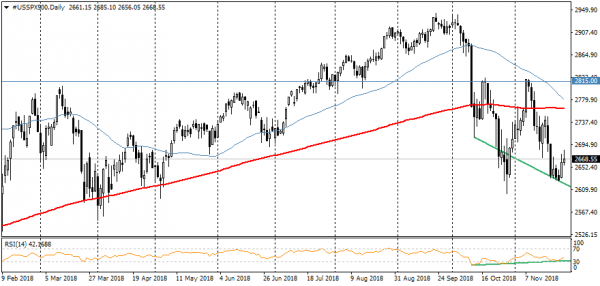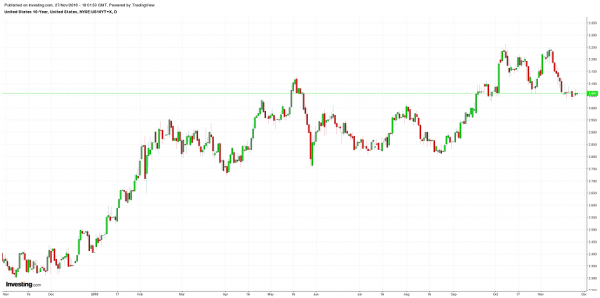A significant market decline often indicates a market correction phase. Last Friday, index S&P 500 closed on the lowest levels for the last six months, losing 10.2% from the September peaks, and marking its entry into the market’s correction phase.
However, the market reactions so far signal that the demand for stock hasn’t changed, and thus the correction phase may not arrive in the near future, as expected.
On Monday, index S&P500 has increased by more than 1.5% while the futures for the index have shown an upturn today morning.
Moreover, the technical indicator –Relative Strength Index – highlights the weakness of the downward trend, taking into account the sequence of the highest lows. However, results show a clear divergence from the price dynamics, since the decline in November was much more profound than in October. Often, such a divergence between the price and the RSI precedes a significant, upcoming rebound.
An important resistance area is situated near 2810, which is 4.7% higher than the current levels, and could become a target for the market bulls.
Among all the support factors, is also the yield decline in the U.S. treasuries, which in turn makes the assets with fixed return less attractive to investors. The yield of 10-year US government bonds reversed to decline from 3.25% to 3.05% twice in November and October, which as a result triggered increased demand for stocks. The latest trigger for the decline was Powell’s recent comments that the Fed could pause the rates’ raises next year, in light of the slowdown of the economy.
Investors should also pay attention to the moderation of the inflationary pressure, after the oil prices collapse. Today and tomorrow, the markets may get further clarification in regard to the Fed’s position and the evaluation of the latest data. Later today, the Fed’s Vice Chairman will give out a speech, followed by the Fed’s Chairman, Jerome Powell, on Wednesday. The confident sentiment prevalent in the economy, and the intentions to stay on course, for 3 or more rate hikes next year, may trigger the dollar to see a rally in the future. However, there is a higher probability towards a shift to a more precautionary stance, that can increase the pressure on the dollar and strengthen stocks.















